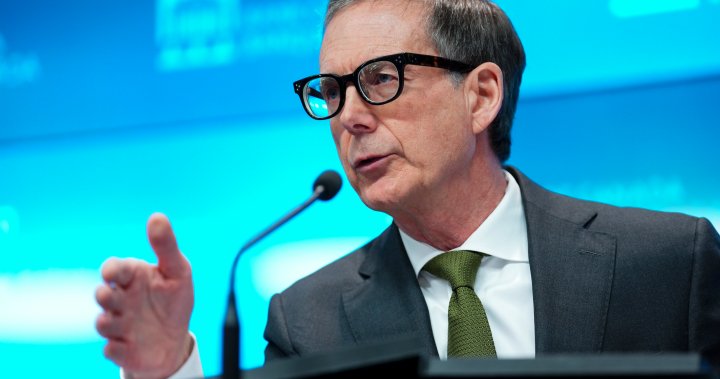The Bank of Canada left its benchmark interest rate unchanged on Wednesday and signalled it’s still too soon to ease monetary policy despite recent cooling in inflation.
The central bank’s policy rate held at 5.0 per cent in the fifth consecutive decision, with the hold widely expected by economists.
The head of the Bank of Canada also said that it’s “too early” to cut interest rates until there’s more progress in taming core inflation, according to prepared remarks from Governor Tiff Macklem.
There have been “no big surprises” in the economic data since the central bank’s hold in January, he said, but underlying price pressures are “persisting.”
“We’ve come a long way in our fight against high inflation. Monetary policy is working—inflation is coming down. But it’s too early to loosen the restrictive policy that has gotten us this far,” Macklem said in his remarks.
“The assessment of governing council is that we need to give higher rates more time to do their work.”

The Bank of Canada’s policy rate sets the cost of borrowing for institutions across the country and informs interest rates Canadians pay on debt, including mortgages and other credit products.
Efforts to tame inflation in the current tightening cycle began just over two years ago and saw the Bank of Canada raise its policy rate by 4.75 percentage points over the course of 10 hikes.
Officials at the central bank have signalled that the benchmark rate might now be high enough, shifting discussions now to how long the rate needs to stay elevated to bring inflation all the way back down to the Bank of Canada’s mandated two per cent target.
Annual inflation cooled more steeply than expected in January, declining to 2.9 per cent from 3.4 per cent the previous month.
Speaking to reporters on Wednesday morning, Macklem highlighted persistently high shelter inflation as the biggest contributor to the rising cost of living, but also flagged that other components of the consumer basket are still trending above three per cent annually.
Financial news and insights
delivered to your email every Saturday.
Food, health and personal care were among categories seeing inflation hold above three per cent in January, according to Statistics Canada.
“There are other underlying pressures beyond shelter. We’re looking at everything together,” he said.
The Bank of Canada expects inflation will float around three per cent through mid-year before declining further, with Macklem adding that some volatility might be expected thanks to gas prices.
The Canadian economy managed to eke out slight gains in the fourth quarter of 2023, outpacing the Bank of Canada’s expectations for flat growth.
TD Bank senior economist James Orlando said in a note to clients Wednesday that the stronger-than-expected GDP figures in late 2023 have put “effectively no pressure” on the Bank of Canada to lift rates, as the economy is avoiding a severe contraction despite restrictive monetary policy.
Macklem noted that the once-tight labour market has slackened and said there are some signs of wage pressures easing, too.
“The labour market adjustment has been relatively gradual, smooth, and we’ve moved from a very overheated market to a better balanced market,” he told reporters.
“Our hope is that we can continue to achieve further progress on low inflation without causing any major disruption to the economy.”

April could bring ‘greater clarity’ for rate cuts: economists
Macklem was pressed by reporters for more guidance on when the Bank of Canada is expected to cut interest rates and at what pace.
Rather than providing specific timelines, he instead told Canadians eagerly anticipating rate cuts to watch the indicators that the Bank of Canada has highlighted to gauge when the policy rate might be ready to lower rates.
“I think we’ll all be able to recognize the progress when we see it, but we can’t put it on a calendar. We are taking each decision one meeting at a time,” Macklem said.
He also said it was “safe to say” that any future cuts won’t be happening at the same pace interest rates were raised.
The Bank of Canada reiterated in its statement accompanying the decision Wednesday that it’s still looking for normalization in wage growth, inflation expectations and corporate pricing behaviour as it gauges where to take the policy rate next.

Macklem’s counterpart south of the border, U.S. Federal Reserve Chair Jerome Powell, has also been somewhat cagey on the timeline for easing monetary policy, but he acknowledged in remarks to members of Congress on Wednesday that rate cuts will “likely be appropriate” later this year, “if the economy evolves broadly as expected.”
CIBC chief economist Avery Shenfeld said in a note Wednesday that the next central bank decision on April 10 will provide “greater clarity” on the rate path, alongside fresh forecasts for inflation and economic growth.
Assuming economic data heading into that decision continues to show signs of progress in the inflation fight, Shenfeld said he believes the Bank of Canada can set expectations for a June rate cut at the next meeting.
Benjamin Reitzes, managing director of Canadian rates & macro strategist at BMO, also said in a note Wednesday that mid-year looks more likely for a start to interest rate cuts. There was little change in messaging from the Bank of Canada on Wednesday, which puts up a “pretty high bar” for a shift to rate cuts by April.
“At this point, the BoC looks comfortable holding rates steady through the spring, as there’s still a fair amount of wood to chop on inflation,” he said.
Shortly after the rate announcement, data via Reuters showed that Canadian money markets now see a 23 per cent chance of a rate cut in April, down from 43 per cent. They have also pushed back bets for a fully priced in cut to July from June.
– with files from Reuters

© 2024 Global News, a division of Corus Entertainment Inc.





